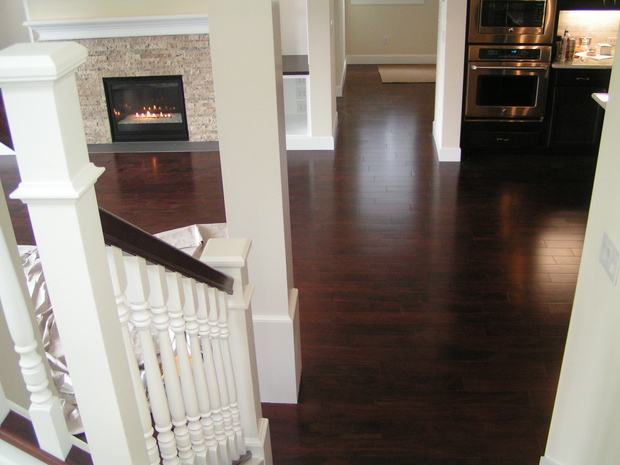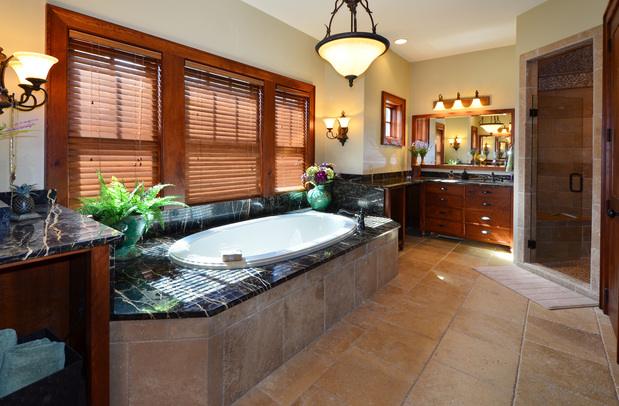This blog was contributed by HomeAdvisor.
Buying and installing a new floor can be overwhelming. There are a number of options to choose from, all of which appear on the show floor to look amazing in any home. There are also a number of variations in price and -- even if you research flooring installation costs -- it’s difficult to determine what will fit into your budget. The sheer variety in flooring makes deciding which option will best meet your needs seem downright impossible.
Before you decide to spend hours online or walking back and forth through a home improvement store, learn more about the top four flooring options homeowners invest in to see if they’re the right fit for your home:
#1: Hardwood Flooring
 Hardwood flooring never goes out of style -- and it is durable and low-maintenance as well. You can either install real wood strips or engineered planks, which can be made moisture-resistant with the right stain and finish. Usually, you’ll want to go with the engineered wood if it’s laid in the kitchen. That’s because the planks include a layer of plywood under a veneer of real wood that can withstand humidity and temperature changes -- the kind a kitchen goes through with a lot of cooking. Hardwood flooring is perfect for just about any room in the home, and it is ensures a return on your investment should you ever wish to sell.
Hardwood flooring never goes out of style -- and it is durable and low-maintenance as well. You can either install real wood strips or engineered planks, which can be made moisture-resistant with the right stain and finish. Usually, you’ll want to go with the engineered wood if it’s laid in the kitchen. That’s because the planks include a layer of plywood under a veneer of real wood that can withstand humidity and temperature changes -- the kind a kitchen goes through with a lot of cooking. Hardwood flooring is perfect for just about any room in the home, and it is ensures a return on your investment should you ever wish to sell.
The biggest downside to installing a hardwood floor is the initial cost. The cost to install a hardwood floor averages between $4,200 and $5,900, depending on square footage and the type of wood material you choose; engineered wood will cost less than solid wood, for example. Hardwood can also be quite noisy when you step on it with heels or other clacky shoes. Solid wood floors need regular maintenance and refinishing -- and you must be careful not to leave puddles on the wood, as doing so could cause it to warp.
Hardwood floor courtesy of Stanbrooke Custom Homes, Inc.
#2 Sheet or Tile Vinyl
Vinyl is another popular flooring choice. It’s affordable -- usually less than a dollar per square foot; it can be installed it in either sheets or tiles; and it is noise canceling and quiet as well. Vinyl lasts for a anywhere from 10-20 years with proper maintenance. It’s a practical choice for the bathroom or laundry room because it adds warmth to the room and comes in a wide variety of styles to match any design.
The downside to tile vinyl is that tiles usually start to come up after a while; this is not a problem with sheet vinyl. Vinyl also stains, dents and tears easily, and it can be a pain to clean. Vinyl is unattractive to some homeowners because of its look and texture, despite the numerous other materials it can mimic. And, it’s a poor choice from an environmental standpoint -- both because manufacturers use petroleum resources to produce vinyl and because it often releases indoor air chemicals after installation.
#3 Ceramic Tile
Ceramic tile is waterproof and fairly inexpensive, which is why many  people choose it for bathrooms and kitchens. It’s also a good fit in the dining room, since it can withstand spills and accidents. There are various types of ceramic tile to choose from -- including tile that mimics the appearance of stone, octagonal and hexagonal shapes, and even mosaic tiles that come in plastic mesh sheets to make installation easy.
people choose it for bathrooms and kitchens. It’s also a good fit in the dining room, since it can withstand spills and accidents. There are various types of ceramic tile to choose from -- including tile that mimics the appearance of stone, octagonal and hexagonal shapes, and even mosaic tiles that come in plastic mesh sheets to make installation easy.
One problem with ceramic tile is that it’s cold to the feet. Installing heating underneath tile is expensive, and it’s a task that many homeowners just don’t want to take on. Ceramic tile can also be slippery. And, like wood flooring, it can be loud to walk on as well. Tiles are prone to cracking, which can lead to potentially difficult and expensive repairs. And you have to regularly clean the grout in between the tiles to keep it looking fresh.
Ceramic tile floor courtesy of VPC, LLC.
#4 Carpet
Carpet is soft and warm, and it also helps to insulate and soundproof a room. This is why most homeowners choose carpet for bedrooms and home offices -- places with low traffic where they rest and relax. It’s also one of the quickest and simplest flooring options to install because it can adapt to old subfloors and uneven areas.
The downside to carpet is that it stains easily. It also builds up dirt and dust that even frequent vacuuming can’t combat -- a serious issue for people with allergies. Carpet should be steam cleaned regularly. And, given its shorter lifespan, it should be replaced more often than other flooring materials.
These are top four flooring options, but they are by no means inclusive of all that’s available. Homeowners can choose from linoleum, laminate, concrete and other subtypes of stone flooring as well. It all depends on what best suits your budget and the needs of your household. You also should consider what will attract a potential homebuyer down the road. These four flooring options top the charts because they are the most common in homes across the United States.
Photos courtesy of DesignMine









The look of brand new hardwood floors, or even newly refinished hardwood floors, adds an unmistakable quality and value to your home. Thank you for sharing.